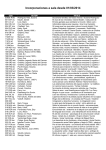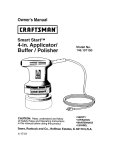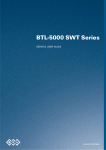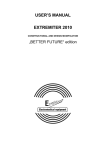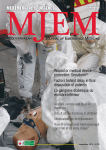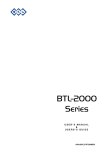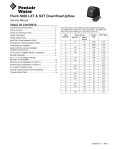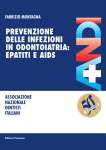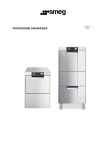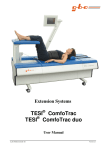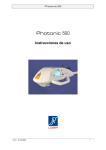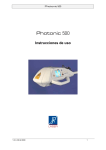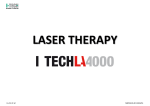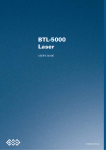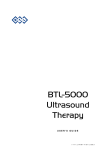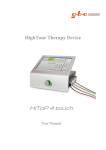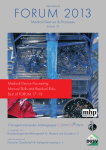Download VAS – 07 „BETTER FUTURE“ edition
Transcript
USER’S MANUAL VAS – 07 CONSTRUCTIONAL AND DESIGN MODIFICATION „BETTER FUTURE“ edition User´s Manual • VAS-07 „BETTER FUTURE“ edition 1 TABLE OF CONTENTS 1. Intended Use and Basic Description of the Device......................................................... 3 2. General Information............................................................................................................ 5 2.1 Device Manufacturer:............................................................................................................ 5 2.2 Authorised Distributor and Service ....................................................................................... 5 2.3 Purpose of the User’s Manual .............................................................................................. 5 2.4 Guarantees ........................................................................................................................... 5 2.5 Safety Instructions ................................................................................................................ 6 2.6 Technical Characteristics of the Device VAS-07, „BETTER FUTURE“ Edition ................. 10 2.7 Indications and Contraindications of Distance Electrotherapy .............................................. (Electrodeless, Contactless) ............................................................................................... 11 2.7.1 Indications and Administration of Distance Electrotherapy Procedures............................. 11 2.7.1.1 Classification According to Indication Groups .................................................................... 15 2.7.1.2 Classification According to Treated Localities .................................................................... 19 2.7.2 Contraindications, Risks, and Side Effects of Distance Electrotherapy ............................. 29 2.7.2.1 Contraindications ................................................................................................................ 29 2.7.2.2 Risks ................................................................................................................................... 31 2.7.2.3 Side Effects......................................................................................................................... 31 3. Technical Description of the Device............................................................................... 33 3.1 Description of the Device Assembly ................................................................................... 33 3.2 Description of the Intelligent Instrument Unit...................................................................... 34 3.3 Legend Description on the Device...................................................................................... 38 4. Operation of the Device VAS-07, „BETTER FUTURE“ Edition..................................... 39 4.1 Installation of the device ..................................................................................................... 39 4.2 Operation of Mechanical Parts of the Device ..................................................................... 41 4.3 Operation of the Instrument Unit of the Device VAS-07, „BETTER FUTURE“ Edition ...... 42 4.4 Cleaning and Disinfection ................................................................................................... 57 4.5 Maintenance ....................................................................................................................... 58 4.5.1 Regular Functional and Safety Checks of the Device ........................................................ 58 4.6 Environmental Protection and Disposal of the Device ....................................................... 59 4.7 Packaging ........................................................................................................................... 59 4.8 Storage ............................................................................................................................... 59 4.9 Transport ............................................................................................................................ 60 4.10 Environmental Conditions Under Operation of the Device VAS-07, „BETTER FUTURE“ Edition ................................................................................................................................. 60 5. Certification ....................................................................................................................... 61 User´s Manual • VAS-07 „BETTER FUTURE“ edition 2 1. Intended Use and Basic Description of the Device The purpose of the device VAS-07, „BETTER FUTURE“ edition, is to provide low-frequency pulse and medium-frequency electro-therapeutic currents, without the need to apply contact electrodes on the patient’s body, with the aim of achieving favourable therapeutic influencing of painful conditions, and to support healing, regeneration, or repair of the locomotor system tissues. Relevant physical and therapeutic procedures are referred to as distance electrotherapy (DET). Fig. 1 Caution: If the device is switched on and the procedure is started, the operator of this device must not be closer than 15 cm from the applicator in use of pulsed currents, and 25 cm in use of interference currents; other persons must not be closer than 25 cm from the applicator in use of pulse currents, and 50 cm in use of interference currents (according to assessment of exposure situation at the electrotherapeutic device VAS-07, „BETTER FUTURE“ edition, and according to the limits stipulated in the governmental order of the Czech Republic No. 480/2000 Coll. on health protection against non-ionizing radiation, in conformity with the Regulation for limiting exposure by timevarying electric, magnetic, and electromagnetic fields of the ICNIRP commission (International Commission on Non-Ionizing Radiation Protection: Guidelines for Limiting Exposure to TimeVarying Electric, Magnetic, and Electromagnetic Fields); in accordance with the legislation of the European Community, measured by the accredited National reference laboratory for non-ionizing electromagnetic fields and radiation, the State Health Institution in Prague). Operating mode of the device According to the viewpoint of the international commission ICNIRP and Governmental Order of the Czech Republic No. 480/2000 Coll. (in conformity with the requirements of the European Union), in applying the DET procedure, it is necessary to meet the following distance from the applicator: for OPERATOR for OTHER PERSONS Pulse currents 15 cm 25 cm Interference currents 25 cm 50 cm The manufacturer recommends doubling the distance from the applicator in the course of running procedure, i.e. 0.5 metre for the operator and 1 m for other persons. Pregnant women and persons using electronic prostheses must be fully ruled out from operation of this device, as well as from administration of procedures. User´s Manual • VAS-07 „BETTER FUTURE“ edition 3 The VAS-07, „BETTER FUTURE“ edition, is a medical device intended for professional use in the health sector in order to provide physical and therapeutic procedures of distance, or contactless (electrodeless), electrotherapy utilising the physical and therapeutic effect of eddy electric currents, developing on the basis of Faraday electromagnetic induction, created in the tissues being treated when a device applicator is located in close proximity of these tissues. The evident and well proven biological activity reaches up to the distance of approximately 25 cm from the applicator. The device produces two (2) basic types of electrotherapeutic currents: - pulse currents interference currents. Pulse currents utilise the therapeutic effect of narrow, low-frequency electrical pulses, ranging from one (1) Hz to several hundreds Hz, whereas in the course of one procedure, more frequencies can be combined in a sequential manner, and this combination can be periodically repeated. Interference currents utilise the therapeutic effect of low-frequency shock waves, developing by interference of two harmonic (sinusoidally oscillating) electromagnetic fields of medium frequencies around 5000 Hz, whereas the low-frequency shock waves can have frequencies from 1 to 400 Hz with the possibility of fluent frequency changes according to various therapeutic spectrums (fast, slow; triangular, trapezoidal, and rectangular) and with a fluently rotating vector of the electromagnetic field. At the present time, a generally known number of applications (indications) exist for the group of pulse and interference currents in the treatment of painful conditions, to support healing, regeneration, and repair of the locomotor system tissues. Specific frequency and time parameters are required for individual diagnoses. For this reason, one or more therapeutic pulse currents, or one or more therapeutic interference currents, can be allocated to individual diagnoses. This allocation is made on the basis of generally available knowledge from technical literature, professional communication, generally acknowledged parameters of worldwide accepted electrotherapeutic devices of various manufacturers, as well as on the basis of medical experience with the previous types of the device VAS-07 manufactured by the company Embitron. In this manner, 131 diagnoses and indications of 341 pulse and 319 interference electrotherapeutic currents is programmed in the device VAS-07, „BETTER FUTURE“ edition within the framework of the „Standard Procedures“ folder. Individual diagnoses are structured according to indication groups (vertebrogenous diseases, degenerative diseases, inflammatory diseases, diseases of veins and lymph, bone diseases, traumas and similar diseases, diseases of muscles and nerves, entezopathy, and other); as well as according to localisation of problems (21 localities on the patient’s body). Note: Application of electrotherapeutic current according to localisation of problems is very effective under normal practical conditions, therefore, all these 21 locations are schematically represented on the indication and control panel of the device. In addition to pre-programmed electrotherapeutic currents, the user of the device VAS-07, „BETTER FUTURE“ edition, can develop other electrotherapeutic currents with fully individual parameters, namely in the „User Procedures folder“. Any of the electrotherapeutic currents from the „Standard Procedures“ folder, as well as from the „User Procedures“ folder can be stored in another separate folder named „Favourite Procedures“ with a view of their further quick and operative use under a selected name, or patient’s symbol, or procedure. In addition, the device VAS-07, „BETTER FUTURE“ edition, contains additional more than 100 programs intended for application of special procedures (for example, for transcutaneous electrical nerve stimulation TENS, application of Nogier, Bahr, Claus, and Reininger frequencies, application of frequencies to achieve cyclotron resonation in order to influence electrically charged particles passing through the cell membrane). The front side of the therapeutic applicator of the device VAS-07, „BETTER FUTURE“ edition, which is to be applied to a treated part of the patient’s body, is equipped with powerful, red light emitting LED diodes. This represents secondary phototherapy applied simultaneously with distance electrotherapy. In order to increase its effect, the therapeutic luminous flux is polarised and modulated by its own universal frequency program independent on used frequencies of distance electrotherapy. User´s Manual • VAS-07 „BETTER FUTURE“ edition 4 2. General Information 2.1 Device Manufacturer: EMBITRON s.r.o., Borska 55, 301 00 Plzen, Czech Republic www.embitron.cz; www.embitron.eu [email protected]; [email protected] 2.2 Authorised Distributor and Service For the Czech Republic: EMBITRON s.r.o., Borska 55, 301 00 Plzen, Czech Republic For the Slovak Republic: EMBITRON s.r.o., Borska 55, 301 00 Plzen, Czech Republic For other countries: see the list of the authorised distributors and services 2.3 Purpose of the User’s Manual The purpose of this manual is to provide users of this device and relevant responsible organisations with the necessary information needed for its handling and safe operation. If the user, or the person responsible, does not understand nor has any doubts, he/she must immediately contact the manufacturer or the authorised distributor. This manual is intended for all users of the device and responsible organisations, which use this medical device in any manner (they: prescribe administration of therapeutic procedures by means of this device, recommend this device to therapeutic, preventive, or reconditioning use, apply therapeutic procedures, operate this device, or supervise the use of this device, and are responsible for operation of this device). This user’s manual must be part of every device and available to all persons working with the specified device in any way. 2.4 Guarantees In accordance with the legal provisions in force and unless otherwise stipulated in a purchase contract, the guarantee period for the device VAS-07, „BETTER FUTURE“ edition, is 24 months as from the date of its sale. In the event of warranty claims, the properly completed guarantee certificate must be submitted. The guarantee period shall be extended by the time for which the device was repaired in the guarantee time. The guarantee cannot be accepted if the device was not used in accordance with the accompanying documentation (User’s Manual) and in accordance with relevant statutory provisions, regulations, and standards. The guarantee shall not be applied to any damage caused by incorrect or improper use of the device, and damage caused by the operating personnel without proper qualification and/or training in use of this device. In addition, the guarantee shall not relate to damages caused by fire, water, static electricity, over-voltage, accident, mechanical damage, unprofessional interference with the device, unprofessional installation, discharged or flat accumulators or batteries, as well as consequences of natural wear and tear, and consequence of a force majeure event. Other conditions for acknowledgement of this guarantee are specific for medical devices: – – – – A medical device must undergo regular checks of functionality and safety (periodic inspections). These inspections may be performed only by exclusively authorised service care provider(s), All service work on the device may be performed only by the authorised service care provider(s), From the viewpoint of legal requirements for complete traceability (vigilance) of medical devices, the manufacturer of the device must know a final user of this device, or relevant responsible organisation, The medical device must be properly installed in the user’s premises, and operating personnel must be demonstrably trained. EMBITRON s.r.o is an exclusive authorised provider of service care for this device in the Czech Republic and Slovakia. User´s Manual • VAS-07 „BETTER FUTURE“ edition 5 2.5 Safety Instructions The device VAS-07, „BETTER FUTURE“ edition, was designed and manufactured for the safest use. However, its safe (as well as purposeful and effective) use intends on the qualified procedure prescription, proper operation, and necessary care and caution. Improper use of this device may result in serious consequences. It is necessary to observe all safety instructions and other information provided for the device VAS-07, “BETTER FUTURE“ edition, as well as information in connection with the physical and therapeutic method of distance electrotherapy (i.e. contactless, electrodeless). It is also necessary to follow further development of knowledge in this area of medicine, to apply therapeutic procedures by persons having relevant medical qualification, and to observe all necessary legal provisions, regulations, and recommendations. Users of this device must have available information provided by this user's manual, or other information provided within the framework of training for operating personnel, or in connection with other utilisation of the device VAS-07, „BETTER FUTURE“ edition, and applying the physical and therapeutic method of distance electrotherapy (contactless, electrodeless). In using this device within the framework of health care service provision, a particular procedure must be prescribed by a qualified health care professional, and the operating personnel of this device must also be medically qualified and appropriately trained for operation of this device. The device must not be used: - to other purposes than the intended purposes of use, in an external environment, in an environment with the increased risk of electric shock (for example, humid or wet environments, or environment with moving and unsecured mechanical substances), in an explosive environment, in an environment with the high risk of fire, if exposed to adverse weather conditions, in inadmissible technical adjustments, in noncompliant conditions of electric power supply, in absence of a fully responsible user, proper prescription of therapeutic procedure(s), and/or qualified and trained operating personnel, in a situation when the patient (client) or his justified interests, or operating personnel, and third persons might be threatened by this device, or by the administered therapeutic procedure, or when any other detriment might be caused. Special warnings: • • • When prescribing and applying procedures, it is necessary to respect thoroughly all contraindications, risks, and possible side effects, and always assess individual and actual patient’s conditions, as well as other factors. The patient’s body parts coming to contact with this device must be fully intact or must be treated or covered in such a way that contact with this device or its parts could not cause any risks to the patient or other persons coming to contact with this device. switched on and the procedure is started, the operator of this device must not be closer than 15 cm from the applicator in use of pulsed currents, and 25 cm in use of interference currents; other persons must not be closer than 25 cm from the applicator in use of pulse currents, and 50 cm in use of interference currents (according to assessment of exposure situation at the electrotherapeutic device VAS-07, „BETTER FUTURE“ edition, and according to the limits stipulated in the governmental order of the Czech Republic No. 480/2000 Coll. on health protection against non-ionizing radiation, in conformity with the Regulation for limiting exposure by time-varying electric, magnetic, and electromagnetic fields of the ICNIRP commission (International Commission on Non-Ionizing Radiation Protection: Guidelines for Limiting Exposure to Time-Varying Electric, Magnetic, and Electromagnetic Fields); in accordance with the legislation of the European Community, measured by the accredited National reference laboratory for non-ionizing electromagnetic fields and radiation, the State Health Institution in Prague). The manufacturer recommends doubling the distance from the applicator in the course of running procedure, i.e. 0.5 metre for the operator and 1 m for other persons. Pregnant women and persons using electronic prostheses must be fully ruled out from operation of this device, as well as from administration of procedures. User´s Manual • VAS-07 „BETTER FUTURE“ edition 6 • • • • • • • • • • • • The device may be used only in a sufficiently stable position. Falling of any part of the device must be effectively prevented. Any handling with the device applicator may be performed only if the operating personnel hold the applicator firmly to prevent any undesirable movement. Fixation bolts stabilising the applicator in a selected position must always be firmly tightened. Special care must be taken to a vertical movement of the applicator with a carrying arm. The released and unsecured applicator can slide down the guide pole, and result in injury of surrounding persons, or its serious damage. It is necessary to check regularly the integrity of all device parts, in particular electric cables and encapsulated part of the device. Non-original parts must not be used as parts of the device, no adjustment can be done except for those explicitly approved by the manufacturer. The device VAS-07, „BETTER FUTURE“ edition, is a medical device. For that reason, functional checks and safety checks must be performed on a regular basis. These checks are required by relevant statutory provisions (in all EU countries). It is the responsibility of the user and responsible organisation to perform these checks. These functional checks and safety checks may be performed only by the manufacturer of the device, or by the subject authorised to do so by the manufacturer. This subject must be qualified, trained, and equipped with properly calibrated measuring equipment. After proper education, the patient (client) may be left under the remote supervision of a qualified medical operating personnel during the procedure only under the condition that his/her health condition and physical and mental capacities enable this. If these conditions are not fulfilled in a reliable way, the patient (client) must be under the permanent supervision of a qualified health care professional during the procedure and shortly after its finishing (if, for example, the risk of collapse condition exists due to blood pressure reduction, or neurovegetativelly at psychically labile individuals). The device VAS-07, „BETTER FUTURE“ edition, is a medical device which must not be operated without the supervision of a responsible and qualified health care professional. This person must be able to assess, and correctly and reliably interpret, anamnestic and diagnostic points leading to effective, purposeful, and safe application of DE procedure (contactless, electrodeless). In doing so, this responsible person must also consider all other diagnostic results regarding a particular patient (client), patient's (client’s) personality, and all potential risks. It also must take into consideration the viewpoint of preliminary caution, as well as the current knowledge of medical science and research, technical progress, medical legislation, and medical ethics. The patient (client) must be monitored in the course of procedure administration and after them, and, based on the patient’s reaction to DE procedures, if necessary, the original therapeutic decision must be re-assessed (for example, within the meaning of increased number of doses, reduced number of doses, continuation in a series of procedures, repetition of a series of procedures, reduction of the number of procedures, immediate discontinuation of procedure administration, and the like). The user of the device VAS-07, „BETTER FUTURE“ edition, is bound to ensure the device against the risk of fire in a manner that is similar to other electrical appliances supplied from the power supply network. Any abnormal temperature rise of the device (or any of its parts) is a reason to its immediate switch off, disconnection from the power supply, and subsequent calling a professional repair service. Ventilation openings or encapsulated parts of the device must not be covered under operation of the device, and the device must not be hermetically closed. It is necessary to prevent from ingress of foreign objects and liquids into the device, undesirable vibrations, and sudden temperature changes. If a risk of moisture condensation exists (condensation of air water vapours in transfer from colder to warmer areas), the device can be switched on only if it is completely dry. Covers of the device may be removed only by the manufacturer, or subject authorised by the manufacturer to perform technical service. Similarly, no other person can disassembly, repair, modify, or otherwise intervene with the device. If this rule is violated, the user of the device will loose the guarantee, and there is also a risk of arbitrary injury and other damages. Prior to cleaning or disinfecting the device or any of its parts, the device must be switched off and the detachable mains supply (incoming mains cord) must be disconnected from the power supply by withdrawal of a mains plug from the socket. User´s Manual • VAS-07 „BETTER FUTURE“ edition 7 • • • • • For cleaning and disinfecting, it is necessary to use only safe and well-proven cleaning and disinfecting agents, and, in no case, admit ingress of any liquids into the device or any of its closed (encapsulated) parts (instrument unit, applicator). CAUTION: Alcohol-based agents must not be used for cleaning or disinfecting of any part of the device. This caution is to be applied, in particular, on the emitting surface of the applicator made of cast Plexiglas. It is also not allowed to use any abrasive cleaning agents or tools which would scratch surfaces. The device VAS-07, „BETTER FUTURE“ edition, similarly as with other usual electric instruments, must not be operated in the vicinity of water sources (such as bath-tubs, wash-basin, sinks, swimming pools, laundries, humid basements, and the like). Similarly as with other devices producing electromagnetic fields, also with the device VAS07, „BETTER FUTURE“ edition, it is necessary to avoid contact with magnetic fields with instruments, devices and technical means that are sensitive to action of electromagnetic fields, can change properties and function due to their influence, or can be damaged by them (for example, computers, monitors, memories, data carriers, electronic recording equipment, electronic watches, chip code cards, and the like), similarly as all other usual electric instruments. The manufacturer of the device VAS-07, „BETTER FUTURE“ edition, does not answer for damage arising from failure to meet this requirement. CAUTION: Special care should be taken to the fact that no invasive and non-invasive electronic means ensuring vital functions of patients must get into influence of electromagnetic field of the applicator of the device VAS-07, „BETTER FUTURE“ edition. Even though the device meets all internationally acknowledged requirements for electromagnetic compatibility, the above-mentioned safety precautions must be observed. • • The detachable mains supply (incoming mains cord) of the device VAS-07, „BETTER FUTURE“ edition, must not be located in areas where the cord could be interrupted or violently pulled out from a socket of electric distribution network or appliance inlet on the real panel of the instrument unit. The device VAS-07, „BETTER FUTURE“ edition, must be immediately switched off, detachable mains supply (cord) disconnected from the line power supply, and, subsequently, the authorised service should be contacted if any or more of the belowspecified cases occur: - • • the detachable mains supply (incoming mains cord) is damaged or worn-out, the device is exposed to action of water or other liquid, which would leak into its interior, the device does not work normally, changes in performance or behaviour can be seen, non-typical sounds can be heard, or smoke/fume or any odour can be felt, the device was damaged by fall or impact, the device shows damaged covers, encapsulated parts (instrument unit, applicator), and/or parts responsible for mechanical stability (special care should be taken to integrity and function of fixation ball threads at the spherical head of the applicator and on the vertical guide rod), the supply cable for connection of the applicator, or its connectors, is damaged. The front side of the therapeutic applicator of the VAS-07, „BETTER FUTURE“ edition, which is to be applied to the treated part of the patient’s body, is equipped with 24 or 40 powerful red light emitting LED diodes. This represents supplementary phototherapy applied simultaneously with electrotherapy. Although the luminous flux does not reach dangerous values for human eyes, the manufacturer does not allow to look directly at this light from a distance lower than 2 m, or to look at the emitting area of the applicator even from a higher distance. As this light is modulated with various frequencies, it appears in the form of irregular rhythmic flashes. In sensitive persons, looking at these flashes should cause problems (dizziness, nausea, and the like), therefore, these persons should not be allowed to look at this supplementary phototherapy. In photosensitive persons, it is also necessary to exclude the action of this supplementary phototherapy on skin. Phototherapy must not be administered shortly after application of CO2 injections. The use of the device VAS-07, „BETTER FUTURE“ edition, must never became a reason for failure to perform or taking away other necessary medical care procedures. User´s Manual • VAS-07 „BETTER FUTURE“ edition 8 • • • • • • • In the course of operation of the device (running therapeutic procedure), it is not allowed to handle the applicator and/or disconnect its electric supply cable. The operating personnel must not touch the running applicator. If the applicator’s position must be adjusted, this must be performed at the time when administration of electrotherapeutic procedure is not running. The device may be operated only with a fully inserted and secured connector, connecting the instrument unit with the device applicator. CAUTION: The electric voltage on the connector for connection of the applicator cable can reach the peak value of 150 V. The warning sign at the „APPLICATOR“ connector on the rear side of the instrument unit indicates the presence of electric voltage on this connector, intended for power supply of the therapeutic applicator. The operating personnel must regularly check the quality and integrity of cables, connector, and plastic cover (encapsulation) of the applicator. If any damage is found, the device must be immediately shut down from operation and authorised service must be contacted. Persons operating the device VAS-07, „BETTER FUTURE“ edition, are obliged to avoid influences of electromagnetic fields to the maximum possible extend. The applicator is to be applied to the treated part of the patient’s body when the procedure is not running, and the start of the procedure is to be done subsequently from the instrument unit located on the opposite side of the instrument stand than the applicator. At the time of starting the device, the operating personnel, standing in front of the control panel of the instrument unit, is at a sufficient distance from the applicator applied in the vicinity of the patient’s body. From the viewpoint of preliminary caution, pregnant persons and persons with electronic prostheses (such as pacemaker) are not allowed to advance towards, or stay in the influence area of the developing electromagnetic field of the applicator. Similarly, from the viewpoint of preliminary caution, these persons are not allowed to operate the device, or to be treated with this device. User´s Manual • VAS-07 „BETTER FUTURE“ edition 9 2.6 Technical Characteristics of the Device VAS-07, „BETTER FUTURE“ Edition Health classification Medical device of Class II a in accordance with the Council Directive 93/42/EEC Electrotechnical classification Device supplied from the external power supply source AC power supply network 230 V / 50 Hz; or 115 V / 60 Hz if so modified by the manufacturer. From the viewpoint of protection against electric shock, the device of Class II Electrotechnical standard used CSN EN 60 601 – 1 (IEC 601 – 1) Classification of application part of the electric medical device BF (according to Czech standard CSN EN 60 601–1, equivalent to ICE 601-1) Classification from the viewpoint of protection against ingress of water or solid parts IP 40 (according to IEC 60 529) Classification for operation: in areas: permanent, internal, normal areas without increased risk Sterilization: This device is not to be sterilized Power supply voltage: Power required 230 V / 50 Hz, alternating, sinusoidal; or (if so modified by the manufacturer): 115 V / 60 Hz, alternating, sinusoidal 25 VA Protection of electrical power supply Fuse 315 mA, time-lag fuse (T), located inside the instrument panel Magnetic induction produced by the applicator Interference currents (peak value at one polarity): 1 mT Pulse currents (peak-peak value of pulses): 2 mT Intensity of induced electric voltage and electrically induced current produced by the applicator in tissues (maximum preliminary values) Interference currents: (peak value at one polarity): 2 7.2 mV/cm; 0.5 A/m (at a specific conductivity of tissues 0.6 S.m) Pulse currents: (peak-peak value of pulses): 2 1.5 mV/cm; 0.1 A/m (at a specific conductivity of tissues 0.6 S.m) Pulse width of excitation voltage: 150 µs or 340 µs; from frequency of 450 Hz only pulse width of 150 µs; frequency 1 – 1 200 Hz at pulse therapies up to 3 123 Hz; randomised frequency 1 – 999 Hz Frequency of interferences: 1 – 400 Hz st Frequency of the 1 excitation coil: 4 000 – 6 000 Hz harmonic course nd Frequency of the 2 excitation coil: 4 000 – 6 000 Hz harmonic course Wave length: 660 nm Frequency: 2 – 160 Hz Pulse width: 3 ms – 100 ms Luminous intensity: 1 000 mcd Linearly polarized emission Entire device assembly including packaging: 14.5 kg Entire device assembly without packaging: 12.5 kg Instrument unit: 2 kg Applicator: 2 kg Applicator arm: 1.5 kg Device assembly (packaged): 1400 x 800 x 800 mm Entire device assembly (solo): 1300 x 750 x 750 mm Instrument unit: 305 x 270 x 120 mm Applicator: 205 x 145 x 70 mm Pulse induced electric currents Interference induced electric currents Luminous flux produced by the applicator (24 or 40 LED, 5 mm in diameter, water clear, flaring angle 12 deg) Weight Dimensions Material of plastic casing ABS (acrylnitrile-butadien-styrol) and Plexiglas GS Surfaces of metallic parts Stainless, komaxtit or ecological plastic PA 11 RILSAN User´s Manual • VAS-07 „BETTER FUTURE“ edition 10 2.7 Indications and Contraindications of Distance Electrotherapy (Electrodeless, Contactless) 2.7.1 Indications and Administration of Distance Electrotherapy Procedures Distance electrotherapy is intended mainly for supportive physical therapy in treatment of all algic (painful) acute conditions of the locomotor system (in particular traumatic and/or inflammatory nature), as well as chronic conditions (usually degenerative). In degenerative diseases of the locomotor system, distance therapy is used with the aim of pain relief and support of regeneration or repair of tissues, in particular, in the events of arthroses, chondromalacies, entezopathies, vertebrogenous algic syndromes, and the like. In treatment of fresh and older posttraumatic conditions, distance electrotherapy is used with the aim of pain relief and support of healing in the events of distortions, contusions, posttraumatic oedemas, haematomas, hemarthroses, fractures, ununited fractures, to support healing of ligaments, tendons and damaged articular capsules, in treatment of consequences of injuries and surgical operations, in treatment of algodystrophic syndromes, and the like. DE can also be used as supportive treatment of peripheral capillary return disorders of various aetiology, especially micro-angiopathies and functional disorders of peripheral capillary return. DE can be effectively used in treatment of trophic disorders, in particular, venous ulcers, mainly postphlebic, arterial, and diabetic. Nevertheless, the favourable effect has been reported also in treatment of varicose ulcers and mixed ulcers. In addition, DE can be used to support regeneration of damaged axons of peripheral nerves, innervating skeletal muscles, at muscular asthenopia, in treatment of cutaneous sensation disorders, at anaesthesia and some types of peripheral pareses, in treatment of vasoneuroses and various neuropathies and polyneuropathies, especially diabetic ones. Procedures of DE can also be applied in supportive treatment of osteoporoses, mainly in problem parts of skeleton (neck of femur, area of Colles fractures on the radius and ulna, threatened vertebral bodies, area of the LS spine and hips), in supportive treatment of aseptic bone necroses, and as support in healing of fractures. DE can also be used in supportive therapy of some diseases of skin tissues (in particular, already mentioned thropic changes, regeneration of damaged skin surface, inflammatory and cicatricial complications of acne, some constitutional dermatitis, lichen simplex, and the like), and in dermatic and cosmetic applications (striae, weak skin, cellulitis). DE can also be used outside the area of locomotor system therapy in cases when use of electric therapeutic currents (and associated electromagnetic fields) is generally known and it is beneficial for the patient, without being endangering. This regards supportive therapy of some functional and vegetative and regulation processes in the organism or possibility to use specific frequencies with anticipated biological effects (Nogier, Bahr, Claus, and Reininger frequencies, resonation cyclotron frequencies, and other), applied within the framework of acupuncture (especially at contactless electrostimulation of introduced acupuncture needles), as well as in regulatory and holistic medicine. Dosage of DE is always individual, whereas therapeutic benefits and possible risks must be taken into consideration. The procedure time is usually 15 to 30 minutes for interference electrotherapeutic currents, and 15 to 60 minutes for pulse electrotherapeutic currents. In wellsubstantiated cases, the time of one application can be doubled (for example, in treatment of fractures, aseptic bony necroses, venous ulcers, acute posttraumatic pain, and the like). As a rule, procedures are administered on a daily basis (less frequently every other day) in a series of mostly 10 to 20 procedures with a possible repetition of this series several times a year (usually 2 to 4 times). In some indications, in particular, support healing applications (fractures, ununited fractures, bony necroses, venous ulcers, and other thropic defects, and the like), it is possible to apply continuously also other series of procedures if a therapeutic benefit is clear and no risks exist. In painful conditions at degenerative diseases of the locomotor system (such as arthrosis), however, the distinctive therapeutic effect should be seen during the series of max. 20 procedures (which corresponds to one month time period). If the therapeutic effect does not appear after this time, it mostly has no sense to continue in administering the procedures. User´s Manual • VAS-07 „BETTER FUTURE“ edition 11 Note: It is the responsibility of a qualified physician to decide about the selection of pulse or interference currents for the treatment of particular diagnosis and patient. From the biophysical viewpoint, it can be generally declared that at interference therapeutic currents applied in the form of DE using the device VAS-07,„BETTER FUTURE“ edition, a more significant and faster therapeutic effect can be expected, however, associated side effects (such as increased soreness during the first and several first applications) may occur. During application of interference currents, it is also necessary to take care of relative contraindications (for example, heating of endoprothesis). Pulse currents, however, can also be effective enough in many cases that they can exceed generally more radical interference currents, especially if these currents are close to TENS type currents for pain relief on the basis of return theory, or on the basis of endorphin production stimulation, and currents close to SP type according to Professor Basset, intended for support of healing and neovaskularisation, and the like. In order to make easier prescription and administration of DE procedure, all pre-programmed procedures are summarised in the following list of diagnoses and/or indications (see Table 2.7.1 - 1). Note: Some of the specified diagnoses and/or indications may overlap somewhat. Some of the diagnoses and/or indications are identical even though they have various names. In this manner, searching of a required diagnosis and/or indication is facilitated for various users utilising a different terminology. User´s Manual • VAS-07 „BETTER FUTURE“ edition 12 Table 2.7.1 - 1 Diagnosis or indication Ordinal number in alphabetical order 1 2 3 4 5 6 7 8 9 10 11 12 13 14 15 16 17 18 19 20 21 22 23 24 25 26 27 28 29 30 31 32 33 34 35 36 37 38 39 40 41 42 43 44 45 46 47 48 49 50 51 52 53 54 55 56 57 58 59 60 61 62 63 64 65 66 International terminology Acne Acrocyanosis Acroparaesthesia, acrodysaesthesia Acupuncture contactless stimulation of the needles Adhaesio dolorosa Achillodynia Algodystrophic syndrom - lower limb Algodystrophic syndrom - upper limb Alloplastica Analgia - Analgesia Arthritis rheumatica Arthritis urtica Arthrosis acuta exacerbans Arthrosis chronica Arthrosis oedematosa Atherosclerosis - ischaemia peripherica Bursitis acuta Bursitis chronica Calcar calcanei Celulitis Cicatrix cheloidea Cicatrix chronica Cicatrix recens Claudicatio intermitens Combustio Contractura Contusio Coxarthrosis - coxalgia Decubitus Degeneratio spinalis Distensio muscularis Distortio Dolor (p.e. postoperativa) Dolor postextractionem (stomatologia) Dolor temporomandibularis Dorsalgia Dupuytren's contractura Eczema Enthesopathiae Epicondylitis Fractura Frozen shoulder Gonarthrosis - gonalgia Haemarthrosis Haematoma acuta Haematoma chronica Hypertonia musculorum Hypotonia musculorum Cheloidum Chondropathia patelae Ischialgia Laesio ligamenta cruciata Laesio menisci Lumbalgia Luxatio Lymphoedema M. Bechterevi M. Bürger M. Osgood-Schaltter M. Perthes M. Raynaud Metatarsalgia Migraena Mikroangiopathia Musculus abbreviatus Musculus scissus User´s Manual • VAS-07 „BETTER FUTURE“ edition 13 Diagnosis or indication Ordinal number in alphabetical order 67 68 69 70 71 72 73 74 75 76 77 78 79 80 81 82 83 84 85 86 87 88 89 90 91 92 93 94 95 96 97 98 99 100 101 102 103 104 105 106 107 108 109 110 111 112 113 114 115 116 117 118 119 120 121 122 123 124 125 126 127 128 129 130 131 International terminology Myalgia Myogelosis Myopathia Myorelaxatio Neuralgia Neuralgia n. occipitalis Neuralgia nervi trigemini Neurodermatitis Neuropathia Paraesthesia, Dysaesthesia Obstipatio atonica Obstipatio spastica Oedema acuta Oedema chronica Omarthrosis - omalgia Osteochondrosis Osteonecrosis aseptica Osteopathia Osteoporosis Osteosynthesis Ostitis Paresis nervi musc. Paresis nervi facialis Paresthesia acralis Parodontis (stomatologia) Pelvipathiae Periarthritis humeroscapularis Periostitis Post - poliomyelitis syndrom Pseudoarthrosis (ununited fractures) Regeneratio cutaneus sensibilitas Regeneratio nervi periferi Sacralgia Sanatio postoperativa Sanatio posttraumatica Spasticis - myospasmus Spondylarthritis ancylopoetica Spondylarthrosis - spondylopathia Stimulatio medullae osteae Striae Sy. canali carpi Sy. cervicalis Sy. cervicobrachialis Sy. cervicocranialis (occipitalis) Sy. lumbosacralis Sy. Sudeck Sy. Tietz Sy. trigeminus facialis Sy. varicosum Sy. vertebralis (VAS) acuta Sy. vertebralis (VAS) chronica Tendinitis acuta Tendinitis chronica Tendopathia Tendovaginitis acuta Tendovaginitis chronica Tension headache Tonisatio musculorum Torticollis Triger points profundus (deep) Trigger points superficialis Ulcus cruris Ulnarthrosis - ulnpathia Vasoneurosis universalis Zetema articulatio sacroiliacalis (SI) All the specified diagnoses and indications are included in the „Standard Procedures“ folder where they are classified either according to indication groups or selected localities of the body. User´s Manual • VAS-07 „BETTER FUTURE“ edition 14 2.7.1.1 Classification According to Indication Groups Vertebrogenous diseases: User´s Manual • VAS-07 „BETTER FUTURE“ edition Degenerative diseases: 15 Inflammatory diseases: User´s Manual • VAS-07 „BETTER FUTURE“ edition Circulatory disorders: 16 Osteopathies: User´s Manual • VAS-07 „BETTER FUTURE“ edition Traumas and their consequences: 17 Disorders of muscles and relevant nerves: diagnoses/indications: User´s Manual • VAS-07 „BETTER FUTURE“ edition Entezopathy and other: 18 2.7.1.2 Classification According to Treated Localities User´s Manual • VAS-07 „BETTER FUTURE“ edition Locality: sacroiliacal Locality 2: sacroiliacal Locality: neck Locality 1: neck 19 User´s Manual • VAS-07 „BETTER FUTURE“ edition Locality: rear thigh Locality 4: rear thigh Locality: lumbosacral Locality 3: lumbosacral 20 Locality 6: shoulder User´s Manual • VAS-07 „BETTER FUTURE“ edition Locality: hip Locality 8: hip Locality: front knee Locality 7: front knee Locality: shoulder Locality: rear chest Locality 5: rear chest 21 User´s Manual • VAS-07 „BETTER FUTURE“ edition Locality: side knee Locality 10: side knee Locality: thigh Locality 9: thigh 22 User´s Manual • VAS-07 „BETTER FUTURE“ edition Locality: wrist Locality 12: wrist Locality: arm Locality 11: arm 23 Locality 14: elbow User´s Manual • VAS-07 „BETTER FUTURE“ edition Locality: elbow Locality: forearm Locality 13: forearm 24 User´s Manual • VAS-07 „BETTER FUTURE“ edition Locality: lumbar Locality 16: lumbar Locality: paravertebral Locality 15: paravertebral 25 User´s Manual • VAS-07 „BETTER FUTURE“ edition Locality: leg, distally Locality 18: leg, distally Locality: tarsus Locality 17: tarsus 26 Locality: ankle Locality 20: ankle Locality: calf Locality 19: calf User´s Manual • VAS-07 „BETTER FUTURE“ edition 27 Locality: crura Locality 21: crura For each diagnosis or indication, there are 1 to 3 therapeutic pulse electric currents available and 1 to 3 therapeutic interference electric currents - 341 pulse and 319 interference electrotherapeutic currents in total. User´s Manual • VAS-07 „BETTER FUTURE“ edition 28 2.7.2 Contraindications, Risks, and Side Effects of Distance Electrotherapy By its pulse and interference currents, DE is a demonstrably effective form of electrotherapy. As every really effective therapy, it also has some contraindications, risks, and possible side effects. Knowledge about them is developing; for example, new contraindications may paper or, on the contrary, some current contraindications may be shown as unreasonable. It is the natural duty of the user of this device and responsible organisation to follow the development of this knowledge throughout the service life and use of the device. 2.7.2.1 Contraindications Note: Contraindications are divided to absolute, relative, global (regarding the whole body) and local(regarding only a certain part of the body). According to another point of view, contraindications can be divided to objectively documented (objective) and only potential contraindications – considered only theoretically, and important mainly from the view point of preliminary caution. Absolute and Objective Contraindications: - Administration of DE procedure to a patient with the implanted electric stimulator (for example, most frequently, cardiac pacemaker) or any electronic prosthesis influencing vital functions (for example, electronically controlled administration of insulin), or to a patient whose vital functions are monitored or controlled by electronic devices connected to the patient’s body (for example, at the intensive care unit). Electromagnetic fields and induced electric currents of the device VAS-07, „BETTER FUTURE“ edition, will not damage the patient directly, but they would case a defect in function of electronic instruments, or vital implants. - Administration of DE procedure to a patient in a serious health condition, requiring totally different therapeutic procedures. This regards, for example, cardiac patients with a serious infectious disease, patients under acute attacking conditions, patients with hypertonic or hypotonic crisis, patients with glycemic crisis, patients in the anaphylactic shock or symptoms of allergic reaction, acutely intoxicated patients in a serious condition, and the like. - Pregnancy: Basically, this is a local contraindication regarding the abdominal area of women, in which a foetus is being developed. According to international directives, the safe distance from the applicator is 25 cm for pulse currents and 50 cm for interference currents. This distance is (by the decision of the manufacturer) doubled, i.e. 0.5 m for pulse currents and 1 m for interference currents (introduced safety coefficient 2). Of course, with regard to the severity of foetus development, and from the viewpoint of maximum preliminary caution in the event of pregnancy, the manufacturer recommends to consider pregnancy as global contraindication, i.e. regarding the whole body of a pregnant women. CAUTION: In women in the fertile period, it is recommended to apply DE procedures always only in the period of the 1st half of menstruation cycle (up to ovulation) when exclusion of pregnancy is highly probable. User´s Manual • VAS-07 „BETTER FUTURE“ edition 29 Absolute Contraindications from the Viewpoint of Preliminary Caution: - Oncological diseases and serious precancerous conditions: In the majority of cases when it is possible to determine a localised place of disease, this is a local contraindication. In a sufficient distance from the determined place, DE procedures can be administered. The officially determined distance is 25 cm from the applicator for pulse currents and 50 cm from the applicator for interference currents. The manufacturer recommends doubling this distance, i.e. up to 50 cm from the applicator for pulse currents and up to 1 metre from the applicator for interference currents. - Severe ischemic diseases of vital organs: Here, purely theoretically, during application of DE, a discrepancy may occur between the requirements of tissues for oxygen and inability of atherosclerotic arteries to supply oxygen. This potential risk regards, in particular, the heart or the brain. The real manifestation of discrepancy, however, has never been reported. In addition, this is a local contraindication. In a sufficient distance from the affected vital organ, DE procedures can be administered. The officially determined distance is 25 cm from the applicator for pulse currents and 50 cm from the applicator for interference currents. The manufacturer recommends doubling this distance, i.e. up to 50 cm from the applicator for pulse currents and up to 1 metre from the applicator for interference currents. - Heart rhythm disorders, disorders of electrical transmission heart system, and any related heart diseases: Theoretically, during DE application, the electric heart transmission system could be interfered with the created induced electric currents. This is a local contraindication. In a sufficient distance from the affected vital organ, DE procedures can be administered. The officially determined distance is 25 cm from the applicator for pulse currents and 50 cm from the applicator for interference currents. The manufacturer recommends doubling this distance, i.e. up to 50 cm from the applicator for pulse currents and up to 1 metre from the applicator for interference currents. - Metallic implants in the patient’s body (most frequently during osteosyntheses or application of endoprostheses): The risk of temperature rise or mechanical vibration of the metallic implant exists here. Vibration risks are absolutely negligible. Temperature rise of the metallic implant in use of pulse currents is minimal. In use of generally more effective interference currents, the temperature rise may be quite evident, but in the majority of situation, this does not exceed physiologically acceptable values. Nevertheless, increased caution should be taken when prescribing and applying procedures. This is exclusively a local contraindication. - Severe neurological and seizure diseases: Theoretically, during DE application, the central nervous system (CNS) could be interfered with the created induced electric currents. This is a local contraindication. In a sufficient distance from the CNS localisation, DE procedures can be administered. The officially determined distance is 25 cm from the applicator for pulse currents and 50 cm from the applicator for interference currents. The manufacturer recommends doubling this distance, i.e. up to 50 cm from the applicator for pulse currents and up to 1 metre from the applicator for interference currents. In patients with seizure conditions, visually sensed action of phototherapy is not admissible, as the flashlights could give rise to a seizure. In seriously neurovegetatively unstable patients, DE procedures are contraindicated generally. In these highly labile patients, it is not admissible to use the action of phototherapy with flashlights. - Fresh thrombosis - Menstruation: This is a local and time limited contraindication. The risk of DE administration consists only in the possibility of slightly increased menorrhea. User´s Manual • VAS-07 „BETTER FUTURE“ edition 30 Relative contraindications: Some objective findings bear witness of relative contraindications, but not uniquely, because other objective findings bring contrary results. It is difficult to come to a conclusion if this regards the objective contraindication or contraindication from the viewpoint of preliminary caution, or if this regards a contraindication at all if necessary caution is to be maintained at a particular patient. Therefore, it is the final decision of a physician whether DE is to be applied in particular cases or not, the physician who prescribes a particular procedure, and in co-operation with a medical operating personnel who check the patient. - - - - Application of DE on the area of the head, other big nerve knots, gonads, carotid sinus, heart, endocrine glands, and other vital organs which would be sensitive to effects of electromagnetic fields and induced electric current. Application on developing tissues (in children and juvenile persons). On the contrary, the benefit is reported in treatment of aseptic bony necroses (morbus Perthes) in children. Application on eyes. On the contrary, the benefit is reported in treatment of some degenerative eye diseases, for example, macular degeneration. Application to changed manifestations of skin pigmentation. Diseases accompanied with an elevated temperature. Infectious diseases On the contrary, better use of antibiotic drugs in target tissues is reported. Severe haemorrhagic diseases and radical anticoagulation treatment Systemic neurological diseases Active TBC Vegetative lability Hypersensitivity of patient and resistance to physical therapy with electric current and/or electromagnetic fields. Hypothalamic and hypophyseal disorders Hyperthyroidism Adrenal dysfunction, adrenal hyperfunction Juvenile diabetes Systemic and/or generalised mycoses Myasthenia gravis Autoimmunity diseases 2.7.2.2 Risks According to the current available knowledge of DE effects, failure to meet the above-mentioned contraindications, minimal other residual risks of DE exist, resulting from application of carrying electromagnetic fields and induced electric eddy currents. Only the following information should be noted: - increase in the metabolic activity of treated tissues with all possible consequences (up to a theoretical hypoxic damage), - sudden decrease in blood pressure during the procedure and shortly after the procedure, and resulting transient dizziness and injury of the patient by falling, Caution: During the procedure, the patient should be positioned in a suitable manner (in laying position, sitting position, or in semi-laying position), to prevent the risk of fall, to assist the patient with standing after the procedure, and ask for a short-time monitoring under the supervision of a health care professional. 2.7.2.3 Side Effects The professional medical literature reports that carrying electromagnetic fields and induced electric currents may: - act synergically with antibiotic drugs and phenylbutazone, act antagonistically with steroids, nitrates, calcium antagonists, and beta blockers, decelerate the effect of heart glycosides. User´s Manual • VAS-07 „BETTER FUTURE“ edition 31 The most important side effect for the patient, however, can be increased soreness after administration of the first or several initial procedures. This effect, called the reactive phase, is usually explained on the basis of mechanism of created superoxides, and it is one of the proofs of the effective action of DE. Similar effects are known and theoretically explained also at other forms and types of physical therapy. After the transient increase of soreness following one to three initial procedures, a significant decrease in pain is followed, along with other favourable effects of physical therapy. If, however, the transient increase in soreness is too high, it is necessary to reduce a dosage scheme (to shorten the procedure time, to decrease the current intensity, to select a safer program, and to prolong the interval between procedure administrations). In extreme cases, the treatment should be discontinued. At acute painful situations, for example, injuries, acute inflammation, and the like, the reactive phase usually does not occur, and application of a suitable DE program is usually able to mitigate pain gradually. This response, however, can occur after a variously long time, sometimes significantly exceeding the usual time of procedure. In these cases, DE can be applied for a duration of 1 to 2 hours. User´s Manual • VAS-07 „BETTER FUTURE“ edition 32 3. Technical Description of the Device 3.1 Description of the Device Assembly The device VAS-07, „BETTER FUTURE“ edition, consists of a travelling stand (1) with a fixedly placed own intelligent device unit (2), and a movable placed applicator (3). The applicator (3) is fixed to a swivelling arm of the applicator (4) by means of a spherical head (5). Force, holding the applicator on the spherical head, is adjustable by a manual tightening element (6) used for firm fixation of the applicator in a required place. If, however, this tightening element (6) is tightened only adequately, the applicator can be moved on the spherical head by certain force, to the extent enabled by the spherical head. Then, the applicator stays in a required position where it can be fully fixed by tightening the tightening element (6) and to prevent in this way its undesirable movement. Figure 3.1: Device overall assembly 1 2 3 4 5 6 7 8 9 10 11 12 12a/12b 13 14 15 16 device stand intelligent instrument unit applicator swiveling arm of the applicator spherical head tightening element of the spherical head spherical bushes vertical bar tightening handle safety spring applicator stranded cable connector to connect the applicator: 12a appliance inlet / 12b connector mains power cord braked wheels firm grommet or connector on the applicator matrix of emissive diodes for phototherapy On the opposite side, the applicator arm is fixed to a travel with spherical bushes (7). This travel enables vertical movement of the applicator. In doing so, the travel with spherical bushes (7) slightly moves along the vertical guide bar (8), namely after release of a tightening handle (9). CAUTION: Before releasing the handle (9), the applicator (3) or its arm (4) must always be firmly gripped and held. Otherwise, after releasing the handle (9), the applicator (3) and its arm (4) would fall. This fall can result in damage of the device or injury of persons. Important instructions for the operating personnel: Never release the handle (9) of applicator vertical travel on the guide bar (8) without firmly and permanently holding the applicator (3) and/or its arm (4). The risk of possible damage of the equipment by fall of the applicator (3) with its arm (4) and travel (7) is decreased using a safety spring (10) located at the bottom of the guide bar (8). The applicator is electrically connected to the instrument unit by the applicator cable (11). This cable is terminated with a connector for connection of the applicator to the instrument unit (12, 12a, 12b). This applicator cable (11) is connected to the fully-enclosed applicator body (3) by means of a grommet or connector (15). The intelligent instrument unit (2) and the entire device VAS-07, „BETTER FUTURE“ edition, is to be connected to the electrical line by the mains power cord. The entire device assembly is moved on a device stand (1) by means of braked wheels (14). User´s Manual • VAS-07 „BETTER FUTURE“ edition 33 3.2 Description of the Intelligent Instrument Unit The intelligent instrument unit (position 2 in Figure 3.1; position 1 in Figure 3.2 – 1) is the base unit of the device VAS-07, „BETTER FUTURE“ edition. From the electric viewpoint, this is a device of Class II with the line power supply. The device is placed in a plastic casing – box (position 2 in Figure 3.1; position 1 in Figure 3.2 – 1). The standard AC power supply network is 230 V / 50 Hz. The device can be simply adjusted to 115 V AC power supply network. The power supply voltage is supplied using the detachable power supply cord (2) with a power supply plug (3) and plug connector (4). The plug connector (4) is to be inserted in the appliance inlet (5) at the rear panel of the instrument unit. 1 2 3 4 5 6 12a plastic case (rear panel) detachable mains cord mains plug plug connector appliance inlet power switch connector appliance inlet to connet applicator (see also Fig. 3.1.) Figure 3.2 – 1: Rear panel of the instrument unit Important instructions for the operating personnel: When putting the device into operation, the detachable power supply cord (2) with the plug connector (4) must be connected to the appliance inlet (5) on the body of the instrument unit first, and then the mains cord (3) is to be connected to a mains socket. When disconnecting the device from the electrical distribution system, the procedure is opposite: At the device switched off by the power switch (6), the mains plug (3) should be withdrawn from the mains socket, then the plug connector (4) and appliance inlet may be disconnected and detachable main inlet (2) disconnected. The device VAS-07, „BETTER FUTURE“ edition, may use only the detachable main inlet (mains power cord) provided by the manufacturer as part of the device. In the event of its loss or any damage, it is necessary to replace it only with a mains inlet (cord) provided by the manufacturer or authorised service. The operating personnel must carefully check the condition of the mains inlet (cord) and in the event of any damage or signs of wear and tear, the device must be immediately disconnected from the mains and a new mains inlet must be provided from the manufacturer or authorised service. The operating personnel must connect a detachable mains inlet (mains cord) in such a way to prevent its damage or withdrawal from the mains socket outlet or appliance inlet of the device. As well as, any signs of damage of the appliance inlet (5) and power switch (6) must be a reason for immediate disconnection of the device from the power supply, and call of the authorised service. User´s Manual • VAS-07 „BETTER FUTURE“ edition 34 The front tilted panel of the device consists of graphic display (8) and six control buttons: - - - - the MENU button (9), to call the basic menu of the device, the START / STOP button (10), to start / stop, the button C (11), to return to the state of previous selection, or, in some cases, to prepare the termination of procedure, the button ↵ (12) to confirm selections shown on the graphic display, the button ∆ (13) to increase parameter values, or to move in the display upwards or right, the button ∇ (14) to decrease parameter values, or to move in the display downwards or left. Figure 3.2 – 2: Front panel of Functions of individual buttons are the instrument unit described in more detail in the instructions for use of the intelligent instrument unit (Chapter 4.3 of this manual). The front panel of the intelligent instrument unit schematically shows 21 localities of the locomotor system with the most used procedures of the device VAS-07, „BETTER FUTURE“. These illustrations correspond with the offer of electrotherapeutic procedures for these localities in diagnoses in which they are typically occurred (see Chapter 2.7.1.2 and Chapter 4.3). Inside the intelligent instrument panel casing (position 2 in Fig. 3.1; position 1 in Fig. 3.2-1 and 3.2-2), there is located a highly versatile and safe mains transformer, encapsulated in a separate cover. On the primary winding of this transformer, 230 V AC should be present by default. By simple modification of the transformer block (interconnection of two prepared conductors), this supply can be changed to 115 V AC, and the device can be used in another electrical network. This modification can be performed only by the manufacturer or authorised service. In the vicinity of the transformer, there is a filter, ensuring requirements for electromagnetic compatibility. Voltage of the secondary output of this transformer is 18 V AC, which is led in a separate circuit to a printed circuit board (PCB). This board resolves a decisive part of device electronics. The work of this device is controlled and continually monitored by the microprocessor of ATMEGA 128 type. In the memory of this microprocessor, there are stored all pre-programmed therapeutic procedures and control algorithms. The microprocessor is also the centre of self-diagnosis and self-repair of the device. These advanced technical functions rank the device VAS-07, „BETTER FUTURE“ edition, among the world-unique electronic medical devices. This results in extraordinary high reliability of the device for the user, a negligible risk of defects and ability of the device to adjust its technical parameters automatically and intelligently in such a way that the medical parameters are always optimal under each situation. For example, the microprocessor checks and automatically sets resonance frequencies of both coils in the applicator, which is the necessary condition for creation of interference currents. In addition, the microprocessor checks the temperature in several important places inside the instrument unit case, therefore, overheating of any part of the device cannot occur even extremely energetically demanding combinations of biotropic parameters are selected because the microprocessor automatically reduces the „duty cycle“ in such cases. The microprocessor also monitors and automatically adjusts several internal electric voltages, important from the viewpoint of long-term stability of biotropic parameters and stability of the entire device. User´s Manual • VAS-07 „BETTER FUTURE“ edition 35 The microprocessor accepts instructions entered by the operating personnel by means of six button located on the front panel of the device, and communicates with a graphical display located directly on the board. The foil-type keyboard is connected with the PCB inside the instrument unit with a cable provided with connectors. For cases of software upgrade of the device, a programming connector is located in the vicinity of the microprocessor. The microprocessor memory is backed up with a separate battery. On the PCB, there is created precise and stabilised power supply for the microprocessor, as well as separate power supply for therapy (coils). The level of this power supply is controlled by the microprocessor by means of D/A converters according to a particular program or requirements. There are two electrical circuits for electrotherapy: for pulse therapeutic currents and for interference therapeutic electric currents. For pulse electrotherapy, an exciter of parallel connected applicator coils is created, complemented by patented circuits of time constant regulation (circuits of inductivity discharge and circuits of energy liquidation acceleration from the coils at higher pulse frequencies). By these routes, we can achieve the production of optimum pulses of electrotherapeutic currents, while suppressing the undesirable direct current element. For interference electrotherapy, there are created two separate generators, which produce required frequencies of around 5000 Hz with harmonic (sinus) courses. After amplification, these currents excite separately the applicator coils, but, at the same time, each of the exciting currents is precisely measured by means of galvanically separated sensors. The mentioned values are provided to the microprocessor, which „tunes“ (via the feedback) the optimum resonance frequency at which the required therapeutic currents are created, accompanied by a rotating vector of the electromagnetic field. This solution is patent protected too. In addition, the microprocessor creates a frequency program for supplemental phototherapy with LED diodes, using the red wave length of 660 nm. Pulses for phototherapy with various lengths of 3 ms to 100 ms are repeated with selected frequencies of 2 to 160 Hz. 22 various frequencies with various pulse lengths are used in total. These 22 frequencies were carefully selected to cover the entire frequency spectrum usually used in biostimulation phototherapy. The physician does not need to care of selection of necessary frequency of supplemental biostimulation phototherapy. Each frequency is applied for a duration of 5 to 30 seconds. The entire offer of 22 selected frequencies is provided in 5 minutes and the whole cycle is repeated up to completion of DE procedure. The therapeutic applicator itself (position 3 in Fig. 3.1) is electrically connected via the connector (12), whose appliance inlet (12a) is located at the rear part of the instrument unit case. This appliance inlet (12a) is connected with the PCB inside the instrument unit with a cable provided with a connector on the board. The electric connection – applicator cable (11) is a stranded, fourcore polyurethane cable with double insulation, which is inseparately connected to the encapsulated applicator with a grommet (15). In the optional manufacturing version, connection of the applicator cable (11) with the therapeutic applicator (3) is ensured using a highly resistant, threaded-joint connector. A voltage of 150 V can be present after connection of the applicator (12, 12a), as well as on the applicator cable (11) and on coils inside the encapsulated applicator (3). The safety is ensured by double and multiple insulation and robust and quality manufacturing design. User´s Manual • VAS-07 „BETTER FUTURE“ edition 36 Important instructions for the operating personnel: In the event of any damage to connectors after connecting the applicator (positions 12, 12a, 12b in Fig. 3.1), applicator cable (11), grommet (15) or whole-closing encapsulation of applicator (3) the device must be immediately switched off and disconnected from the mains, and authorised service must be contacted. Naturally, the operating personnel must be particular in avoiding the possible damage of the mentioned device parts. Fig. 3.2-3: Connection of the applicator to the device The encapsulated applicator (3) has an ergonomic shape. Its front area (see the Figure), which is to be applied to the treated body part, is provided with a matrix of 6 x 4 or 8 x 5 (according to type) LED diodes, emitting the red colour of wave length of 660 nm. The LED diodes with protective resistors are connected to the auxiliary PCB located inside the applicator case. Fig. 3.2-4: Front application area of the therapeutic applicator (version with 24 LED diodes) Important instructions for the operating personnel: It is not admissible to expose the persons (or animals) to LED lights for a long-time or from a close distance. User´s Manual • VAS-07 „BETTER FUTURE“ edition 37 3.3 Legend Description on the Device Device name Production edition Manufacturer’s name Manufacturer’s certification Country of origin Electrotechnical classification VAS – 07 „BETTER FUTURE“ edition EMBITRON s.r.o. ISO 13 485 : 2003 Czech Republik, European Union Insulation class II Health classification II a (in accordance with EU Council Directive 93/42/EEC) CSN EN 60 601 – 1 equiv. IEC 601 – 1 230 V / 60 Hz (or, if so modified by the manufacturer: 115 V / 60 Hz) 25 VA IP 41 (IEC 60 529) BF CSN EN 60 601 – 1 equiv. IEC 601 – 1) Electrotechnical standard used Determined power supply voltage Electric input Enclosure of encapsulated parts Type of applied part of device Month and year of manufacture Serial number Warning 1 150V A peak voltage of up to 150 V can be present on the connector for connection of applicator, as well on the applicator cable, and in the applicator Warning 2 Observe the safe distance from the applicator at its turn on: – It does not regard the patient being treated, – It regards the operating personnel and other persons in the vicinity of the device applicator; – This distance is 15 cm for the operating personnel, resp. 25 cm for other persons Fuse Applicator connector Obligatory reference to the Product Documentation FUSE T 315 mA APPLICATOR User´s Manual • VAS-07 „BETTER FUTURE“ edition 38 4. Operation of the Device VAS-07, „BETTER FUTURE“ Edition 4.1 Installation of the device The device VAS-07, „BETTER FUTURE“ edition, can be installed in a very simple way because the unit is mostly pre-assembled. The device assembly is to be only removed out of the shipping case. If you have the device assembly which is not pre-assembled, it is necessary to screw the stand legs (1) and wheels (14). Before the removal of the device assembly from the case, it is necessary to remove a protective insert first, or to place the shipping case in such a way that the device assembly could be carefully pushed out without damaging the assembly and/or shipping case. It is also necessary to check whether all device parts are removed from the case, such as: - accompanying user’s documentation (User’s Manual), detachable mains supply (mains cord) – in Fig. 3.1; position 13, in Fig. 3.2-1; position 2, or shipping documents and other materials, according to agreement with the client. Remove the protective packaging of the device. Place the device assembly on the wheels (14) in a stable manner, unbrake the wheels (by lifting particular levers at the travel wheels), and locate the device assembly to the required place of use. Note: If the device stand (1) was fixed by means of a transport board, strengthening the shipping case, remove both these boards. The applicator cable (position 11, in Fig. 3.1) is usually connected via a particular connector (12) to the instrument unit case (2), which is firmly screwed to the device stand (1). If this is not the case, the plug connector (12) must be inserted into the appliance inlet (12a) at the rear side of the instrument unit (2), and connector secured using an union nut. The plug connector must be slightly inserted full-length – it is impossible to insert it in a wrong way as it is provided with a lock. Special care must be taken to connection of connector (12) for connection of the applicator to the instrument unit (2) as a dangerous voltage of up to 150 V can be generated on this connector during operation of this device. Further installation consists in connection of the detachable mains supply 13 (incoming mains cord): First, insert the plug connector into the appliance inlet at the rear panel of the instrument unit, then insert the plug into the electric socket outlet. Important instructions for the operating personnel: It is necessary to have a duly protected electrical mains distribution 230 V / 50 Hz AC, properly rated to electrical consumers with an input of 25 VA, protection class II. Do not connect the device to the mains distribution system if it was dewy after transport in a cold environment, or if you find any deficiencies or damage of any part of the device due to transport. Before connecting the device VAS-07, „BETTER FUTURE“ edition, it is necessary to acquaint thoroughly with the Accompanying User’s Documentation (User’s Manual). In addition, grip firmly the applicator arm (4), slightly release the tightening handle (9) of travel (7) on the vertical guide bar (8), and turn the applicator arm (4) with the applicator (3) in such a way that the applicator points to the opposite side of the stand (1) than the instrument unit (2). Tighten firmly the tightening handle (9). Subsequently, release again slightly the fixation element (5) of the spherical head (6) at the rear part of the applicator (3). Then, you can set the applicator in such a way that its emitting area (of User´s Manual • VAS-07 „BETTER FUTURE“ edition 39 black colour) points in the horizontal direction, opposite to the instrument unit. Tighten naturally the fixation element (5) so that the applicator can be freely moved only with putting adequate but higher force. This is the basic arrangement of the device before further operation. Important instructions for the operating personnel: - The operating personnel, patient, and other persons may be only at a limited area during the normal use of the device (starting the procedure), Fig. 4.1. - The applicator (3) is an applied part (type BF) - Do not use higher angle of the swivelling arm of the applicator (4) then specified in the figure. - The device must not be placed in such a way that its disconnection from the electrical mains by withdrawal of the plug from the socket is difficult. - The device must not be located in such a ways that its detachable mains inlet could be easily withdrawn from the mains socket outlet or appliance inlet (13a), or the mains supply (cord) is damaged. Fig. 4.1: Limitation of area for the patient and operating personnel CAUTION: switched on and the procedure is started, the operator of this device must not be closer than 15 cm from the applicator in use of pulsed currents, and 25 cm in use of interference currents; other persons must not be closer than 25 cm from the applicator in use of pulse currents, and 50 cm in use of interference currents (according to assessment of exposure situation at the electrotherapeutic device VAS-07, „BETTER FUTURE“ edition, and according to the limits stipulated in the governmental order of the Czech Republic No. 480/2000 Coll. on health protection against non-ionizing radiation, in conformity with the Regulation for limiting exposure by time-varying electric, magnetic, and electromagnetic fields of the ICNIRP commission (International Commission on Non-Ionizing Radiation Protection: Guidelines for Limiting Exposure to Time-Varying Electric, Magnetic, and Electromagnetic Fields); in accordance with the legislation of the European Community, measured by the accredited National reference laboratory for non-ionizing electromagnetic fields and radiation, State Health Institution in Prague). Operating mode of the device According to the viewpoint of the international commission ICNIRP and Governmental Order of the Czech Republic No. 480/2000 Coll. (in conformity with the requirements of the European Union), in applying the DET procedure, it is necessary to meet the following distance from the applicator: OPERATOR OTHER PERSONS Pulse currents 15 cm 25 cm Interference currents 25 cm 50 cm User´s Manual • VAS-07 „BETTER FUTURE“ edition 40 The manufacturer recommends to extent this distance as follows: 0.5 metre for the operator, resp. 1 m for other persons, from the applicator in the course of running procedure. Pregnant persons and persons with electronic prostheses in their bodies must be fully ruled out from operation of the device, as well as from administration of procedures. Important instructions for the operating personnel: Damage of the detachable mains supply (cord) is the most case of electric shock in all electrical mains appliances. Before connecting the device to the electrical mains power supply and/or switch the device on and its operation, it is necessary to check carefully the integrity of the detachable mains power supply, integrity of the applicator cable (11) and its connector (12, 12a), as well as integrity and entireness of plastic insulation encapsulation of the applicator (3) and instrument unit (2). 4.2 Operation of Mechanical Parts of the Device 1. Travel with the entire device assembly, firmly placed on the instrument stand (1). This travel is secured with four wheels (14). When travelling, the wheels must be unbraked (brake levers (14a) are to be lifted). On the contrary, after reaching the required position, the wheels (14) must be braked (brake levers (14a) are to be pressed). When travelling, the detachable mains supply connection (13) must not be at risk. Therefore, before travelling when an undesirable movement of the detachable mains inlet can occur, it is necessary to switch off the instrument unit first, using the switch (number), and then disconnect the mains plug from the mains socket outlet. 2. Setting the applicator (3) position as an applied part of the device. 2.1. Applicator vertical setting: This setting is secured with a vertical travel shift using spherical bushes (7) upwards or downwards the guide bar (8). Before this shift, it is necessary to grasp the applicator arm (4) or the applicator (3), and release the tightening handle (9) on the travel body (7). Upon reaching the required position, retighten the tightening handle (9) firmly. 2.2. Swivelling setting the applicator arm. Again, this positioning is secured by means of travel with spherical bushes (7) on the vertical guide bar (8). CAUTION: Do not exceed the maximum allowed angle according to Fig. 4.1. 2.3. Applicator positioning on the spherical head. This positioning allows applying the front area of the applicator very precisely to a point being treated. By means of the spherical head, the applicator may be tilted in such a way that its front area points downwards vertically. This position is used mainly in treatment of a patient laying on bed or couchette, while the horizontally directing front area of the applicator is used mainly in treatment of a sitting patient. Before positioning the applicator on the spherical head (5), its fixation lever must be slightly released. This release must not be complete, but only to allow the movement of the applicator (3) on the spherical head (5) by the use of adequate force so that the applicator (3) remains independently on the spherical head (5) in a resting state, without its falling. This state can be achieved by adequate tightening / releasing the fixation lever (6) on the spherical head (7). The applicator can be tilted by 90° (from horizonta l to vertical position) in two diagonal positions on the spherical head. This position can be easily found by turning the applicator (3) around its vertical axis. Other operation of the device is performed from the instrument unit (2). User´s Manual • VAS-07 „BETTER FUTURE“ edition 41 4.3 Operation of the Instrument Unit of the Device VAS-07, „BETTER FUTURE“ Edition The instrument unit and device VAS-07, „BETTER FUTURE“ edition, is to be switched on using the rocker switch button (position 6 in Fig. 3.2-1), located at the rear part of the instrument unit in the vicinity of the mains supply plug connector (position 5 in Fig. 3.2-1). The switch is switched on in position „I“ and switched off in position „O“. The graphical display (position 8 in Fig. 3.2-2) on the slant front panel of the instrument unit will light up. Note: If this does not occur, the most frequently this means power failure, omission to connect the instrument unit to power supply by means of mains cord, damage of the mains cord, or failure of the protective mains fuse. Failure of this protective cut-out fuse is very unlike. This fuse is located inside the instrument unit and its replacement, along with finding the cause of its failure and subsequent actions, must be exclusively made by the authorised service. On the graphical display, the „Basic Menu“ window will appear: By means of buttons ∆ (13), ∇ (14), the required position can be searched in the up/down direction, or cyclically. The selection is identified with a highlighted bar, using the inversion colour of fonts (blue in a white bar). The selection is confirmed by pressing the button (12). If the item „Standard Procedures“ is selected in this manner, the following menu will appear: User´s Manual • VAS-07 „BETTER FUTURE“ edition 42 A decision can be made between the next selection of a therapeutic program according to indication groups or according to localisation of patient’s problems. Select and confirm the „Indication Group“ item. The following menu will appear: Within the framework of this offer, 8 indication groups are presented according to the following table: International nomenclature English names Morbi vertebrogenae Vertebrogenous diseases Morbi degenerationae Degenerative diseases Morbi inflammationae Inflammatory diseases Morbi vascularae et lymphae Peripheral arterial circulatory disorders and disorders of lymphatic circulation Morbi osteae Osteopathies Traumae et suae sequelae Traumas and their consequences Morbi musculae et neuralae Disorders of skeletal muscles and peripheral nerves Enthesopathiae et alium Entezopathy and other indications / diagnoses You can move through the menu by arrows ∆ (13), ∇ (14), and selection is confirmed by pressing the button ↵ (12). If, for example, the „Morbi vertebragenae“ item is selected in this manner, the next menu will appear: User´s Manual • VAS-07 „BETTER FUTURE“ edition 43 This menu shows all diagnoses associated with spine disorders, which can be therapeutically influenced by DE administered by the device VAS-07, „BETTER FUTURE“ edition. Other item can be selected and confirmed, for example „Lumbalgia“, and the next menu will appear: 3 pulse and 3 interference electrotherapeutic currents appear in the tabular form. Parameters of these currents can be easily read from the menu table: At pulse currents (marked IMP), Imp is specified; Imp – duration of exciting pulse (µs, microseconds); fI – first used therapeutic frequency (Hz); TI – time of action of the first therapeutic frequency used during each period (ms); fII – second used therapeutic frequency (Hz); TII – time of action of the second therapeutic frequency used during each period (ms). At interference currents (marked INT), the frequency base value (Hz) is specified; i.e. the lowest applied frequency of heterodynes (interference); Swing – sometimes, also designed as „Stroke“, is a frequency by which the base, lowest used therapeutic frequency is periodically increased (Hz); Spectrum – sometimes designed as „Spectral program“ expresses the manner in which the base, lowest applied frequency (Base) will proceed to a higher frequency (determined by the sum Base+Swing) and back. Note: This change can be realised: - - By gradual (linear) growth and subsequent immediate decrease; (schematically shown with a triangle − triangular course). By gradual (linear) growth and subsequent dwell on the maximum applied frequency for a certain amount of time, whereas, the therapeutic frequency will be gradually (linearly) decreased to the minimum applied frequency (i.e. base, the lowest applied frequency), which is, again, applied for a certain amount of time; (schematically designed with a trapezoid – trapezoidal course). By sudden “jump” from the base, lowest frequency to the maximum frequency, which is applied for a certain amount of time, and, again, by sudden “jump” from the maximum frequency to the original base frequency, which is, again, applied for a certain amount of time. In the course of procedure, only 2 frequencies vary: base, the lowest (Base) and the maximum (Base + Swing); schematically designed with a rectangle – rectangular course. Generally, during electrotherapy with interference currents, the triangular course of spectrum is the least radical, the friendliest, and, at the same time, it offers evenly all heterodyne (interference) frequencies applied in a particular therapeutic program. The trapezoidal course of spectrum gives usually more radical effects, and even though it provides all frequencies, it „offers“ in preference two therapeutic frequencies, namely the base frequency and the maximum used frequency. User´s Manual • VAS-07 „BETTER FUTURE“ edition 44 The rectangular course of spectrum can generally be considered most radical. It, however, provides only two therapeutic frequencies: the base one (the lowest) and the maximum frequency. Transition between them is realised in a jump way. Important note: It is the responsibility of a qualified physician to decide about the selection of pulse or interference currents for the treatment of a particular diagnosis and particular patient. From the biophysical viewpoint, it can be declared in general that at interference therapeutic currents applied in the form of DE using the device VAS-07,„BETTER FUTURE“ edition, it can be expected more significant and faster therapeutic effect, however, associated side effects (such as increased soreness during the first and several first application) may occur. During application of interference currents, it is also necessary to take care of relative contraindications (for example, heating of endoprothesis material). Pulse currents, however, can also be effective enough in many cases that they can exceed generally more radical interference currents, especially if these currents are close to TENS type currents for pain relief on the basis of return theory, or on the basis of endorphin production stimulation, and currents close to SP type according to Professor Basset, intended to support healing and neovaskularisation, and the like. CAUTION: Interference currents produce in the treated tissues up to 10 times higher current density than pulse currents. Selection of a particular pulse or interference current is made again using the buttons ∆ (13)∇ (14). Let us select, for example, the second from the offered currents: and confirm your selection by pressing the button ↵ (12). In the display (8), the detailed description of biotropic parameters of the selected therapeutic current will appear. User´s Manual • VAS-07 „BETTER FUTURE“ edition 45 Only three parameters in the lower part of the table can be modified. If no modification of these parameters is intended and their usual automatically preset values are used, you can start a therapeutic procedure right away. To the contrary, the procedure time can be shortened or prolonged, the intensity of applied current can be reduced (or increased), and the work period of current can by changed, i.e. the „duty / work cycle“, which specifies the percent proportion of preselected interval of 30 s will be really produced, and pause will be created in the remaining 30second period of procedure administration. Note: For example, a 50% current period means that the therapeutic current will be produced for 15 seconds and next 15 seconds will not be produced. Of course, in this manner introduced pause reduces the „actual“ time of application of electrotherapeutic current during the procedure but, on the other hand, it eliminates an undesirable effect of reduced efficiency of electrotherapy by creating „adaptation“ of treated tissues to its action. In this manner, the effect of electrotherapy can be increased. At the same time, introduction of a current period („duty cycle“) lower than 100% reduces the current load of some tissues, the risk of possible temperature rise of electrically conductive entases in the body, as well as the risk of undesirable temperature rise of the applicator or instrument unit. Inside the instrument unit, there are special sensors monitoring temperatures at various places of electronic connection, and if acceptable limits are exceeded, the current period value („duty cycle) will automatically be reduced, or application will be automatically terminated. In the following, we will show, for example, how to modify the procedure time. By pressing the button ↵ (12), you will come to the right part of the parameter table and by pressing the buttons ∆ (13)∇ (14), the information can be modified, for example, the procedure time will be shortened up to 15 minutes. A similar procedure will be used if other parameters are modified. The start of an individual therapeutic procedure will be made by pressing the START / STOP (10) button and a relevant indication will appear in the graphical display. User´s Manual • VAS-07 „BETTER FUTURE“ edition 46 The diagnosis is shown in the upper part of the display, showing the remaining time of procedure (the time is deducted, decremented), and schematically it is shown that the pulse electrotherapeutic current was used and the procedure is running („running“ rectangles), and parameters of the procedure are specified in a summary manner. After pressing the START/STOP (10) button, you can terminate the procedure course, or to continue after repeated pressing this button. During the procedure termination, the time count will be stopped. If you want to stop the procedure prematurely (before the expire of the selected procedure time), press the button C (11). A query will appear in the display (8) whether you really want to terminate the procedure or repeat it (from the beginning), or to save it in a special Favourite Procedures folder. If your decision lasts more than 10 seconds, this prompt will disappear and the procedure course will appear in the display. After pressing the button C (11), you will return to the previous state. If the procedure is terminated prematurely, you will return to the basic menu. The MENU button has a totally different function as the button C. If the interference electrotherapeutic current is selected, the further procedure is fundamentally identical with the pulse current. The automatic termination of procedure will occur after the elapse of a pre-selected procedure time. This termination is indicated by the high tone sound lasting for appr. 5 seconds. In this case, you will be prompted to make a decision, whether you really want to terminate the procedure or repeat it, or to save its parameters to the “Favourite Procedures” folder. The menu in the display is identical with the menu shown in Fig. 4.3-10. If you decide to save the finished procedure to the “Favourite Procedures” folder, the following keyboard will appear in the display: User´s Manual • VAS-07 „BETTER FUTURE“ edition 47 You will access the key field by pressing the button ↵ (12). By pressing the buttons ∆ (13)∇ (14), you can select a particular sign, and after pressing the button ↵ (12), you will move to the filed of favourite procedure name (this may be a symbol, abbreviation, patient’s name, diagnosis, and the like). This procedure is to be repeated for every sign of the alphanumeric chain. After finishing the text, use the button ∆ (13) to move to the item “Save”, and confirm this by pressing the button ↵ (12). You can return to the basic menu any time by pressing the button MENU (9); however, if the procedure is running, the procedure must be finished first. If the pre-programmed “Standard Procedures” are selected from the basic menu, but you do not want to use the selection of therapeutic program according to indication groups but according to localisation of patient’s problems, select the item “Trouble Localisation“, and confirm by pressing the button ↵ (12). A selection from 21 localities will paper in the display. The localities are marked with numbers from 1 to 21, which correspond to a particular illustration display of locality in the figures printed on the front panel of the instrument unit. At the same time, the locality is described in words in the display (8) as shown in the below table: Locality number Locality description Figure International nomenclature English names 1 C-Th region 2 Area of SI joint sacroiliacal 3 LS region lumbosacral 4 Thigh–back side rear thigh 5 Chest-back side rear thoracal 6 Shoulder 7 Knee-front side 8 Hip 9 Thigh 10 Knee-medial side 11 Hand hand 12 Wrist wrist 13 Forearm User´s Manual • VAS-07 „BETTER FUTURE“ edition neck shoulder front knee hip thigh side knee forearm 48 14 Elbow elbow 15 Paravert. muscles 16 L region lumbar 17 Talar region tarsus 18 Foot region foot, distally 19 Sura region calf 20 Crural, malleolar ankle 21 Peroneus region crura paravertebral Particular localities in the display (8) can be selected by the buttons ∆ (13)∇ (14), and confirmed by pressing the button ↵ (12). After selection of a required locality, all diagnoses which would have any relations with a particular locality will appear in the display. Of them, using the normal manner you can select the required diagnosis and, after its confirmation, the display will show one to three electrotherapeutic pulse currents and one to three interference electrotherapeutic currents in the tabular form, basically identical with Fig. 4.3 - 5. Other procedure is analogical to the previous one. If you do not want to use the pre-programmed “Standard Procedures” but you want to “set” your own pulse or interference electrotherapeutic currents with your parameters, then select “User Procedures” in the “Basic Menu”. After confirmation of this selection by pressing the button ↵ (12), other options will appear in the display (8): User´s Manual • VAS-07 „BETTER FUTURE“ edition 49 - You can select the procedure entered previously (“Procedure Selection”) - You can enter parameters of your individually created procedure (“Procedure Insertion”) - You can delete the procedure entered previously (“Procedure Deletion”) Note: This menu also accesses deletion of any of the procedures saved in the “Favourite Procedures” folder. In the following, the “Procedure Insertion” will be described: User´s Manual • VAS-07 „BETTER FUTURE“ edition 50 By means of the above-described procedure, the name of the inserted procedure should be entered first: Then, using the buttons ∆ (13)∇ (14), or using the cyclic procedure, you can move to the item IMP (pulse currents) or INT (interference currents) and confirm the required highlighted item by pressing the button ↵ (12). In this manner, you can select / modify all biotropic parameters of the procedure: At pulse currents, this regards the pulse width, the first and second frequency used, and time of action of the first and second used frequency within the framework of one period. At interference currents, this regards the frequency of base, swing, and spectral program (spectrum). Of course, it is also possible to program available parameters (procedure time, intensity of applied electric stimuli, and work period (duty cycle). User´s Manual • VAS-07 „BETTER FUTURE“ edition 51 Once the parameters have been selected, complete the preparation of an individual, user procedure by confirming the item “End with Saving”. User´s Manual • VAS-07 „BETTER FUTURE“ edition 52 If you select “Procedure Selection” in the “User Procedures” folder, the previously created and inserted procedure will be available. Important information: Stochastic (randomised) currents Within the framework of the „User Procedures“ folder, it is possible to create individual pulse electrotherapeutic currents whose frequency is randomly changed at interval from the lowest frequency of 1 Hz up to the maximum frequency which is optionally selected up to 999 Hz. These electrotherapeutic pulse currents are usually referred to as stochastic or randomised. User´s Manual • VAS-07 „BETTER FUTURE“ edition 53 These currents are selected by setting the item Frequency 1 (User Procedures » Procedure Insertion » Procedure Name » Pulse currents IMP » Frequency 1). After marking the Frequency 1 position, press the button ↵ (12). Then, press and hold the button ∆ (13) to achieve and exceed the data 1 200 Hz (the maximum possible adjustable frequency of individual pulses). After exceeding this value, and after holding the button ∆ (13) pressed, the value R001 to R999 will be offered. This value represents an optional upper limit of frequency interval of stochastic currents. This value can be precisely searched by using the buttons ∆ (13)∇ (14). The letter R before the number, specifying the upper interval limit of randomised (stochastic, randomised) frequencies, represents the randomised state, the fact that all frequencies from a selected interval will be given to the patient fully randomly with a same probability during the procedure. The usual upper limits are often 50 Hz, 100 Hz or 200 Hz. The goal of this therapy is to enable the treated tissue to utilise any of the offered frequencies in situation when exact values of required therapeutic frequencies are not known. At the same time, this therapy can eliminate the undesirable habit for electrotherapy and associated reduction in therapy effects (in particular pain therapy). Stochastic therapy is also used in a regulatory medicine. In addition to the folders “Standard Procedures”, “Favourite Procedures”, and “User Procedures”, the basic menu also contains a folder named: “Special Procedures” This folder includes therapeutic procedures whose parameters are based on theories expressed by physicians or scientific and research workers in the field of medicine. These theories are generally known, many physicians prove therapeutic effectiveness on the basis of these theories, but theories are not fully acknowledged in general. The “Special Procedures“ folder is divided into two sub-folders: User´s Manual • VAS-07 „BETTER FUTURE“ edition 54 „Information Therapies“ and „Cyclotron Resonance“: The „Information Therapy“ folder includes, in particular, electrotherapeutic currents for transcutaneous electrical nerve stimulation (TENS), the item: “Transcutaneous Nerve Stimulation“ Individual currents from these electrotherapeutic (electrostimulation) currents should selectively support the development of beta-endorphins, serotonin, and the like, to stimulate production of endogenous opiates, to harmonise the vegetative nervous system, to assist in substance transport during metabolism and tissue detoxication, to stimulate selectively thin nervous tissues, or, on the contrary, to stimulate selectively thick nervous tissues. User´s Manual • VAS-07 „BETTER FUTURE“ edition 55 In the selection of any procedure, physical parameters of this procedure are exactly known and displayed in the display (8). The “Information Therapy“ folder also contains special procedures providing electrostimulation currents with frequencies according to Dr. Nogier, Dr. Bahr, Dr. Claus, Dr. Reininger, and frequencies, which should show affinity to hypothetic routes of the human body, often with identical important vegetative knitting. The maximum applied frequency is limited up to 3 123 Hz. The “Cyclotron Resonance“ folder contains the offer of electromagnetic signals of highly specific quasiharmonic frequencies which would, on the principle of cyclotron resonance in the environment of acting magnetic field of the earth, evoke acceleration of electrically charged particles in the human organism and increase of their energy. The higher energy potential of these particles would be a pre-requisite for their easier interaction with protein carries, ensuring via various mechanisms, and the transfer of electrically charged particles via the cell membrane. This 2+ theory was elaborated mainly for calcium cations Ca , but, on principle, nothing prevents from its utilisation to other electrically charged particles passing via the cell membrane. The calculated increase in energy, which is in a living organism under the threshold of its thermal „noise“, calls against this theory. On the other hand, also very subtle threshold and sub-threshold actions may significantly influence intracellular and extracellular concentration of electrically charged particles, and, at the same time, minor changes of these concentrations may be a significant contribution for the transfer of cell from the pathological to physiological state of its functioning. The “Settings” folder describes technical issues of operation of the device VAS-07, „BETTER FUTURE“ edition. In this folder, you can select a language for communication, keyboard sounds can be switched on/off, the safety code can be switched on/off, and the item “Service Mode“ can be called up. This mode is intended for the personnel of authorised service and its use is not expected by the operating personnel of the device. Nevertheless, below is the brief information: The items AD0 and AD1 show resonance frequencies of electric current in the applicator coils. Without achieving this frequency, it could not be possible to ensure electrotherapy with interference currents. For this reason, electronics of the device VAS-07, „BETTER FUTURE“ edition is solved in such a way to be able always and fully automatically find the optimal resonance frequency at the narrow interval around 5000 Hz, namely, for example, with regard to ageing or after replacement of the applicator. Information at items AD0 and AD1 informs about the optimal resonance frequency of both applicator coils generating electromagnetic field, when the coils include the required angle that is necessary for the creation of interferences in the therapeutic area before the applicator, and to achieve spontaneous vector rotations of the electromagnetic field. Items AD2, AD3 and AD4 specify voltages in important nodes of electric connection of the device. A serviceman can immediately, and without dismounting the device (even remotely), find the place where a defect was shown, find its cause, and operatively ensure its adequate repair. This selfdiagnosis option was incorporated into the device VAS-07, „BETTER FUTURE“ edition, even though technical reliability of this device is extraordinary. Items AD5 and AD6 indicate the temperature which is continually measured in two significant thermally stressed places of the device inside the intelligent instrument unit (position 2 in Fig. 3.1). Operation of the instrument unit in a service mode: The “Service Mode“ is selected from item “Setting“. In the graphical display, the table with four columns and seven lines will appear. The columns show this: Automatically measured and controlled quantity Quantity value in a binary code inside the device User´s Manual • VAS-07 „BETTER FUTURE“ edition Quantity value in common units of measurement (Hz, V, °C) Note 56 The lines show this: Marking Description Value st 4 000 – 6 000 Hz nd 4 000 – 6 000 Hz ADO Resonance frequency of the 1 excitation coil (Hz) AD1 Resonance frequency of the 2 excitation coil (Hz) AD2 Input non-stabilised power supply voltage (V) 15 – 30 V AD3 Excitation voltage in electrotherapy circuits; its size depends on the adjusted intensity of current 1.0 – 12 V AD4 Power supply voltage for sensitive electronics of the device (micro-processor, display) and phototherapy with LED diodes 5.6 – 5.7 V AD6 Temperature of switching transistors of pulse electrotherapy circuits max. 80°C AD6 Temperature of electrotherapy source, utilisation for introduction of a feedback to limit „duty cycle“, or to ensure protective device switch off Max. 115 – 130 °C All the data specified are intended for the personnel of authorised service. These data are also accessible for the operating personnel who can utilise them (for orientation) to specify possible defects remotely (for example, by phone) to personnel of authorised service, or to check the device condition. For practice use, the values of resonance frequencies AD0 and AD1 are important. These frequencies are tuned by the manufacturer in such a way that the instrument unit and applicator work optimal , which is important for the creation of interference electrotherapeutic currents with a rotating vector of the electromagnetic field. If the applicator needs to be replaced, or service actions needs to be done, leading to replacement of excitation coils, their positions, or change in electric properties of their leads, including a particular connector, it is necessary to carry out its precise tuning. This action is ensured automatically by the device VAS-07, „BETTER FUTURE“ edition. In the service mode, press (and hold) the button START/STOP (position 10 in Fig. 3.2 - 2, for 5 seconds as a minimum. Then, the 1st adjusting coil will be automatically tuned, followed by the 2nd coil. This tuning is performed at interval of 4 000 – 6 000 Hz. The resonance maximum is usually found around 5 000 Hz. The device memories the resonance maximum values for all adjusting coils up to possible automatic re-tuning, irrespective of the device switch off. Note: If any of the adjusting coils or their electric circuits is damaged, the value of 0 Hz is set and an „error“ is indicated in a particular note. The manufactuter reserves all rights of changes without previous notice within the meaning of innovations and constructional adjustments. 4.4 Cleaning and Disinfection The device (device assembly) should be kept clean and effectively prevented its excessive pollution of contamination. If the device is not used for a longer period of time, cover it or pack into a protective foil. Under normal operation, dust should be regularly wiped, suctioned, or removed, using soft and dry means. If considerable impurities need to be removed, use a soft gauze, cloth, or sponge slightly User´s Manual • VAS-07 „BETTER FUTURE“ edition 57 humidified with water, or a friendly cleaning agent. Never use alcohol-based cleaning agents, or abrasive means. Important note: Alcohol-based cleaning agents, or abrasive means must never be used for cleaning of the device or its parts. The applicable part of the device (applicator 3, Fig. 3.1) can be applied to the patient’s body in such a way that it will not get in contact with the patient’s body. Induced electric therapeutic currents are created in treated tissues also in the presence of air gaps and obstacles between the front area of the applicator and patient’s body (such as clothing, plaster, gypsum plaster, and the like). This fact can be used sometimes and patient’s non-intact or problem skin should be covered with a sterile bandage, towel, and the like. In this manner, the action of supplementary phototherapy is prevented, but the electrotherapeutic function of the device is not affected in any way. If, in spite of these measures, the applied (or other) part of the device is contaminated, and/or the device must be disinfected before use by another patient, disinfection of any part of the device can be made using common disinfection means according to the Disinfection Order of a particular health facility and/or decision of a responsible physician (health care professional), but using only: - means which not contain alcohol, means which do not leave colour traces or discolouration or damage of surfaces of the device, friendly application of disinfecting means. Important notes: During cleaning and disinfection of the device: - the device must be switched off by withdrawal of the mains plug from the mains socket, must be ensured that any liquids or particles will not ingress into the inside of closed, encapsulated parts of the device – intelligent instrument unit (2) and applicator (3). CAUTION: The applied part of the device is not intended for contact with a non-intact damaged or problematic and hypersensitive skin. 4.5 Maintenance Routine maintenance performed by the operating personnel consists only in a regular and ongoing integrity check of those parts of the device that effect its safety as described in this manual; as well as maintenance of the device in cleanness, or its disinfection, if required. In addition, the operating personnel must observe the instructions specified in this manual or any apprehensible changes in appearance and function of the device or its individual parts. If any discrepancies are found, the authorised service should be contacted. 4.5.1 Regular Functional and Safety Checks of the Device As the device VAS-07, „BETTER FUTURE“ edition, is a medical device whose safety and functionality can be assessed only by the manufacturer, or by qualified and adequately equipped person authorised by the manufacturer, it is the duty of a responsible institution utilising the device to ensure its regular inspection – regular functional and safety checks. The manufacturer recommends performing these checks once per year. A check report must be made about the check performed, and the responsible institution (health facility, physician, or User´s Manual • VAS-07 „BETTER FUTURE“ edition 58 physiotherapeutist) meets in this way the requirements of EU legislation regarding medical devices. In the course of periodic inspection – regular functional and safety checks, the authorised service performs prescribed maintenance actions of electric medical devices, as well as measurement of therapeutic induced electric currents. 4.6 Environmental Protection and Disposal of the Device The device VAS-07, „BETTER FUTURE“ edition, does not have any direct negative impact on the living environment. From the viewpoint of requirements for protection before non-ionising electromagnetic radiation, it is only necessary to ensure that the operating personnel and other persons meet the prescribed protective distances from the running applicator. The device under operation has a small power take-off (max. 25 VA). After the elapse of its life time and putting the device out of operation, it must not be disposed of as municipal waste, but it must be dismounted to individual components as outlined below: - stand (1) instrument unit (2) applicator (3), detachable mains supply (13). Dismounting is performed in a simple way in threaded joints. The metallic stand (1) is to be disposed of as ferrous waste and scrap, other parts as electrical equipment. No dangerous waste is included. The device does not produce any waste products that have the excessive environmental impact. On disposal of the device, contamination of device parts from bodies of treated patients should be considered. Important notice: With regards to its natural wear and tear, material ageing, and, in particular, moral ageing to which all electronic devices are exposed, the life time of the device is 10 years. For this period of time, service and possible deliveries of spare parts are ensured. 4.7 Packaging The device is packaged into inert protective packing foils. In this manner packaged device can be transported only by the manufacturer. For common transport, the device is placed into a shipping case, protected by foam rubber filling, and fixed with fixation boards, if necessary. In addition, the shipping case must contain the Accompanying User’s Documentation (User’s Manual). The shipping case must be properly marked. 4.8 Storage The following storage conditions are to be applied: The temperature of +5 to +45 °C without sudden chan ges. The relative humidity: max. 75%. User´s Manual • VAS-07 „BETTER FUTURE“ edition 59 4.9 Transport Shipping cases with devices can be transported by common covered means of transportation without heavy shocks. The device packaged in a shipping case must be handled with care, similarly as with fragile shipment; side up, do not exceed the permissible storage conditions. 4.10 Environmental Conditions Under Operation of the Device VAS-07, „BETTER FUTURE“ Edition The device is intended for use in normal (safe) areas, in which the use of electrical equipment is common and safe, if this electrical equipment and their use comply with the related provisions, i.e. internal environments (inside buildings), dry, free of dust, without the risk of fire, explosion, without flammable gases and vapours, and the like. User´s Manual • VAS-07 „BETTER FUTURE“ edition 60 5. Certification Subject Certification, testing, reviewing, patent, or other body Regulation (statutory requirement, directive, order, recommendation) Body type Body specifications Protocol Council Directive EU 93/42/EEC Government Order of the CR 336/2004 Coll. EU Notified Body 1014 Electrotechnical Testing Institute, EZU Prague MED 050060 Council Directive EU 93/42/EEC EU Notified Body 1014 Electrotechnical Testing Institute, EZU Prague MED 050060 CSN EN ISO 13 485 idt ISO 13 485 EU Notified Body 1014 Electrotechnical Testing Institute, EZU Prague Electrical and functional safety CSN EN 60 601-1 idt IEC 601-1 EU Notified Body 1015 Engineering Test Institute, SZU Brno Electromagnetic compatibility (EMC) CSN EN 60 601-1-2 idt IEC 601-1-2 EU Notified Body 1015 Engineering Test Institute, SZU Brno Programmable electronic medical systems CSN EN 60 601-1-4 idt IEC 601-1-4 EU Notified Body 1015 Engineering Test Institute, SZU Brno Governmental Order of the CR No. 480/2000 Coll. on health protection from non-ionising radiation (in accordance with the Guidelines for exposure limitation to electromagnetic field of international commission ICNIRP) National reference laboratory for non-ionising electromagnetic fields and radiation The National Institute of Public Health, Prague CE 1014 Quality control system of manufacturer Measurement of electromagnetic field and induction of electric current Act 316/2000 Coll. Edict 316/2000 Coll. Clinical trials CSN EN ISO 14 155-1 CSN EN ISO 14 155-2 idt ISO 14 155-1 ISO 14 155-2 University hospital of Faculty Clinical and of Medicine of the evaluation Caroline workplace University in determined by the Plzen Health Ministry of the CR (EU) Hospital in Pardubice Engineering Test Institute, SZU Brno Risk analysis CSN EN ISO 14971 EU Notified Body 1015 Industrial and legal protection Act 527/1990 Coll. Act 478/1992 Coll. Act 207/2000 Coll. Act 441/2003 Coll. Industrial property Industrial property administration of administration of the CR the CR, Prague Declaration of conformity Act 22/1997 Coll. Manufacturer User´s Manual • VAS-07 „BETTER FUTURE“ edition Embitron s.r.o. Borska 55 301 00 Plzen 30.01.2009 30.01.2012 (audit) 30.01.2009 30.01.2012 (audit) No.: 8090010 30.01.2009 30.01.2012 (audit) 39-8174/E1 11.04.2008 39-8174/EMC1 11.04.2008 39-8174/E1 11.04.2008 EX 080057 Č.j.: 68/08 08.02.2008 27.03.2008 Examiner: Prof. MUDr. Karel Koudela, CSc. 02.06.2008 Examiner: Prim. MUDr. Ivo Jáchym 02.06.2008 VAS-07 ed. „Better Future“(Embitron) 25:03.2008 Distance electrotherapy Device 03.06.2008 VAS-07 edice „Better Future“ 03.06.2008 61





























































